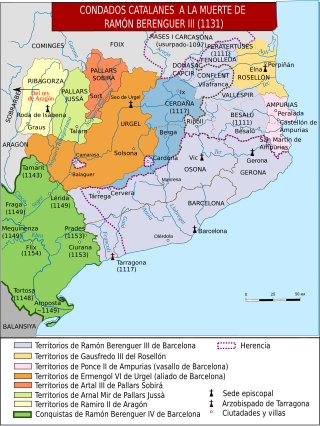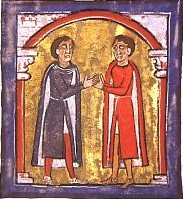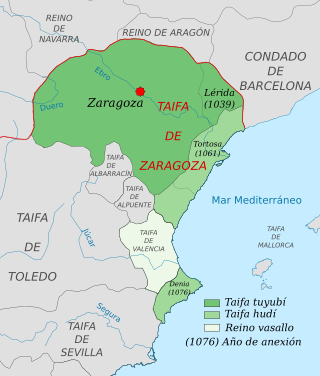
The County of Urgell is one of the historical Catalan counties, bordering on the counties of Pallars and Cerdanya.

Ramon Berenguer IIIthe Great was the count of Barcelona, Girona, and Ausona from 1086, Besalú from 1111, Cerdanya from 1117, and count of Provence in the Holy Roman Empire, from 1112, all until his death in Barcelona in 1131. As Ramon Berenguer I, he was Count of Provence in right of his wife.

Borrell II was the count of Barcelona, Girona and Ausona from 945 and count of Urgell from 948.

Berenguer Ramon I, called the Crooked or the Hunchback, was the count of Barcelona, Girona, and Ausona from 1018 to his death.

Ramon Borrell was count of Barcelona, Girona and Ausona from 992. He was the son of Borrell II of Barcelona and Letgarda of Rouergue, and was associated with his father in ruling the counties from 988.

Wifred or Wilfred was the Count of Cerdanya and Count of Berga. He was the eldest son of Oliba Cabreta and Ermengard of Empúries.

Saint Ermengol or Hermengaudius was the bishop of Urgell from 1010 until his death in 1035.

The Catalan counties were those surviving counties of the Hispanic March and the southernmost part of the March of Gothia that were later united to form the Principality of Catalonia.

Ermengol or Armengol VI, called el de Castilla, was the count of Urgell from 1102 until his death. He was the son and successor of Ermengol V and María Pérez, daughter of Count Pedro Ansúrez, Lord of Valladolid, who became the young Ermengol's tutor when he was orphaned in 1102.
Ermengol or Armengol IV (1056–1092), called el de Gerb or Gerp, was the count of Urgell from 1066 to his death. He was the son of Ermengol III and Adelaide.

Ermengol or Armengol III, called el de Barbastro, was the Count of Urgell from 1038 to his death. He was the son of Ermengol II, Count of Urgell and his wife Velasquita "Constança", probably the daughter of Bernard I, Count of Besalú.
Ermengol or Armengol I (974–1010), called el de Córdoba, was the count of Urgell from 992 to his death. He was the second son of Borrell II of Barcelona and his first wife, Letgarda. He was the second of the counts of Urgell and famous mainly for his participation in the Reconquista.
Guerau IV de Cabrera (1196–1229) was a claimant to the County of Urgel during the time that James I of Aragon was King of Aragon. His uncle, Ponç III of Cabrera, married the daughter of Ermengol VII named Marquesa in 1194. Also, Marquesa’s father, Ermengol VII, was the son of Ermengol VI and his first wife, Arsenda of Cabrera. Through these familial ties to the House of Cabrera, Gerau came to claim the County of Urgell.
Isabella of Urgel was Queen of Aragon; the only daughter of Ermengol III, Count of Urgell by his first wife Adelaide of Besalú.

Bernard I, called Taillefer, was the Count of Besalú in Catalonia from 988 until his death. He was the eldest son of Oliba Cabreta and Ermengard of Empúries, and succeeded his father in Besalú while his younger brothers Oliba and Wifred, inherited Berga–Ripoll and Cerdagne–Conflent, respectively. He was the great-grandson of Wilfred the Hairy, and therefore belonged to the House of Barcelona.
The Battle of Albesa was a follow-up to the Battle of Torà that took place 25 February 1003 at Al-Qaṣr al-Māša (Albesa), near Balagî (Balaguer), between the united Christian forces of the Catalan counties and the Islamic forces of the Caliphate of Córdoba. It was one of the border skirmishes associated with the interminable razzias of the Reconquista, described as "a simple encounter between local forces" and "a local action without overarching importance", though both these views are called into question by the assemblage of important Catalan nobles at the battle and the Muslim reprisal which followed.
William I was the Count of Forcalquier and Marquis of Provence from 1094. He was the second son of Count Ermengol IV of Urgell and the only son of Adelaide of Forcalquier, heiress of Count William Bertrand of Provence.
The Battle of Mollerussa took place in the south of the county of Urgell on 11 or 14 September 1102. In the battle, Count Ermengol V was defeated and killed by an Almoravid army. Mollerussa lies halfway between Bellpuig and Lleida and is the largest town in the Pla d'Urgell.

The Taifa of Lérida was a factional kingdom (ṭāʾifa) in Muslim Iberia between 1039/1046 and 1102/1110. Based on the city of Lérida, the ṭāʾifa was not an independent state throughout this period but was sometimes a part of the larger ṭāʾifa of Zaragoza ruled by a governor (wālī).
The Conquest of Balaguer was the capture of Balaguer by Ermengol VI of Urgell from the Almoravids in 1105.












